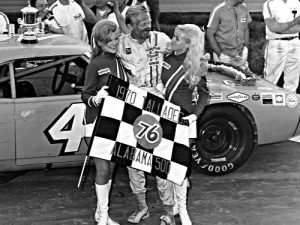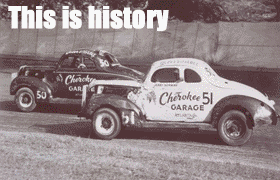
Pete Hamilton stands in victory lane after a win at Talladega Superspeedway in 1970. Hamilton, the 1970 Daytona 500 winner, passed away this week at the age of 74. Photo: RacingOne/Getty Images
Pete Hamilton, the 1970 Daytona 500 winner and a member of the Georgia Racing Hall of Fame, passed away on Wednesday.
Originally from Newton, Massachusetts, Hamilton began his storied racing career in 1962 in the Street division at Norwood Arena Speedway. From there, he went on to score the Thompson World Series Twin 50s at Connecticut’s Thompson Speedway in 1965. He would compete in Hobby Stock, Sportsman and Modifieds around the New England area.
Hamlilton then moved to the NASCAR Sportsman Division, now called the NASCAR Xfinity Series, scoring the series championship in 1967 while racing in 127 events throughout the year.
“That was a lot of time spent on the road,” Hamilton said in an interview with Raceweek Illustrated in 2012. “But it paid off.”
That title opened the door for a move to NASCAR’s Grand National Series, which is now known as the Monster Energy NASCAR Cup Series. That meant a move south.
“It was certainly the best thing I ever did from the standpoint of racing,” Hamilton said.
In 1968, Hamilton began running on NASCAR’s Grand Touring Series, and also competed in several Grand National events. Driving a Ford for in 10 starts and in six events in a Dodge for A.J. King, Hamilton snagged the NASCAR Rookie of the Year honors in the Grand National Series.
The next year, Hamilton continued competing in both series, winning 12 of 26 races on the Grand Touring schedule.
It was during his Grand Touring stint that Hamilton got his first taste of racing in Georgia, at Atlanta’s famed Lakewood Speedway.
“My first real introduction to Georgia racing was at Lakewood,” Hamilton said.
He had won the pole for the GT race on the treacherous one mile dirt track, with another master of the series, the late Tiny Lund, on the outside of the front row.
“Tiny Lund said ‘Now yankee, I’m going to beat you down into that first turn’ and I said ‘Tiny, I don’t think you’re going to do that buddy.’ Well, we went down into the first turn on the first lap of the GT race, and we didn’t make it out of the first turn. Forget going through the second turn. We went straight into the wall, the both of us!”
Hamilton said it was a memory he and Lund laughed about for years afterwards.
Hamilton’s strong run in the GT series garnered the attention of Richard Petty, who was looking for a teammate at Petty Enterprises in Plymouth’s new winged Superbird for 1970 on the Grand National tour.
“When I finally came south in 68 and raced for rookie of the year, I got to know Richard really well, and I kept up that relationship. I think he may have got a kick out of this Yankee boy, and I certainly got a kick out of him and what he was doing.”
“So when he called me up, he already knew me pretty well,” Hamilton continued. “And not only did I know him and know of him, but I had studied what he had done.
“It took me less than five minutes to tell him I would be up there. An hour and 15 minutes later I was in Level Cross, North Carolina.”
Hamilton would see his greatest success in the Grand National tour behind the wheel of a Petty blue No. 40 Plymouth. In his first outing for Petty Enterprises, he captured the biggest prize in NASCAR – the Daytona 500.
It came down to a late race duel between Hamilton and one of NASCAR’s all-time greats, Hall of Famer David Pearson. With tires at a premium over the closing laps, the key moment for Hamilton came with a call on a pit stop, where Richard Petty, who had fallen out early with engine trouble, helped with the call.
“Towards the end of the race, David and I were running one-two,” Hamilton said. “We were at the front of the pack and pulling away from some of the other people. We had a caution flag and came into the pits. David took two tires, and Richard called me back in the pits to take on left sides. So I had four fresh tires, and he had two. That was something that really paid big dividends.”
Over the final 20 laps, as Pearson’s car slipped and slid around on hot asphalt, Hamilton’s Plymouth stayed glued to the track. Pearson tried one last maneuver on the final lap, but couldn’t make his way around Hamilton as he sped to the biggest win of his career.
“It was a real thrill for me, I guarantee you,” Hamilton said.
Hamilton would go on to score two more wins that year, sweeping both races at Talladega Superspeedway.
But cutbacks by Chrysler for the next season meant Hamilton was out of the Petty camp for 1971. He would move on to drive for Cotton Owens, scoring a win in one of the two Daytona 500 qualifying races. It would mark the final victory on NASCAR’s premier series for him.
Despite losing the ride in the No. 40 Plymouth, Hamilton was grateful for all he had learned driving for Petty Enterprises.
“I was new to the whole deal, and I was anxious to learn,” he said. “As a result, I’d keep my mouth shut and I’d learn.”
He took knowledge and revolutionized short track racing.
“I could see that I needed to build some kind of a niche for myself in this racing thing, and if I was able to continue driving fine. If I wasn’t able to continue driving, I needed to do something,” Hamilton said. “So my wife and I moved to Atlanta. Atlanta seemed to be a fine place to set up a business, and the kind of business we decided to set up was a race car fabrication business.”
Hamilton set up shop in Norcross, Georgia, where many winning race cars rolled out of their facility on Buford Highway.
“I was comfortable with building the cars, and I had worked a lot with Chrysler Engineering, and one engineer in particular, Larry Rathgeb. I knew what I wanted in a car. We started immediately building short track race cars.”
Hamilton not only built the cars, but he also raced them. And he won. He scored a major victory in the 1974 Snowball Derby at 5 Flags Speedway in Pensacola, Florida, along with victories at South Alabama Speedway, Jefco Speedway (now Gresham Motorsports Park) in Jefferson, Georgia and elsewhere.
“By virtue of driving and winning and stuff like that, it helped with the selling of those cars,” he said.
So what made a Pete Hamilton car so good?
Hamilton said it went back to the things he learned from Petty Enterprises and Chrysler, specifically the geometry of the front ends, which mimicked as closely as possible those of the Grand National cars of the day.
He put winning cars under the likes of Georgia drivers Charlie Mincey and Billy McGinnis, who would score several victories with their Hamilton mounts.
But Hamilton said the number success with the cars he built came from Georgia Racing Hall of Famer Ronnie Sanders.
“He won the Snowball, he won a lot of different races at race tracks that I had won on before,” Hamilton said.
Hamilton would continue to build cars for the next 10 years before retiring.
In 1998, he was honored by his home area by being inducted into the inaugural class for the New England Auto Racers Hall of Fame. In 2012, he was also honored by his adopted home state of Georgia as an inductee into the Georgia Racing Hall of Fame in Dawsonville, Georgia.
“Most everybody here, whether they were a race driver, mechanic or worked on a car, there’s nothing in the world that we would rather do than that right there,” Hamilton said at the Georgia Racing Hall of Fame induction banquet. “That was racing a car, being there at the track, doing the things we did. For a lot of people, including myself, sometimes it was tough, sometimes it was hard. We didn’t always win, but we always tried real hard.”
Pete Hamilton was 74 years of age.





















Leave a Reply
You must be logged in to post a comment.